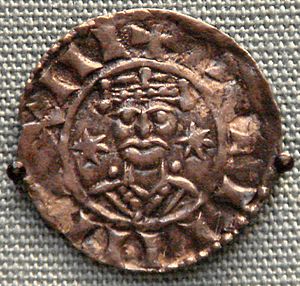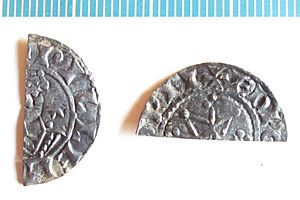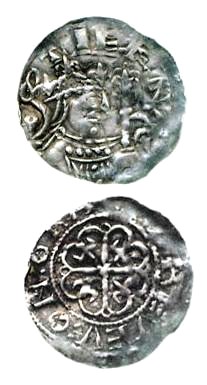History of the English penny (1066–1154) facts for kids
The English penny has a long and interesting history! This article will explore how pennies were made and used in England from 1066 to 1154, during the time of the early Norman kings.
Contents
The early Norman kings
When William the Conqueror took over England in 1066, he kept the same money system that the Anglo-Saxons used. Back then, a penny was worth a lot! If people needed smaller change, they would cut a penny in half or into quarters right at the place where coins were made, called a mint.
Most pennies from King William I and William II showed the king's face looking straight ahead. This was different from the Anglo-Saxon kings, who usually showed the king's face from the side. Around the king's face, there was writing like PILLEMUS REX or PILLEM REX ANGLOR. This meant King William or William King of the English. The letter P might have been an old letter called wynn, which sounded like "w".
On the other side of the coin, called the reverse, there was usually some kind of cross. Around the cross, there was writing that told you the name of the moneyer (the person who made the coin) and the mint (the town where it was made). Even though there wasn't much space, the moneyer's name was very important. It usually appeared after a small cross, followed by "ON" (meaning of) and the town's name.
During William I's rule (1066–1087), many coins were needed. About 70 mints were busy making coins. By the time William II died in 1100, only 34 mints were still working.
King Henry I's Pennies
During the long rule of King Henry I (1100–1135), the penny was still the main coin. Round halfpennies and quarter pennies were made, but people didn't like them much. Today, we only know of about twelve halfpennies and no round quarter pennies from this time.
Fifteen main types of pennies were made during Henry I's reign. About 54 mints were open at different times. At the start of his rule, the coins were not very good quality. Moneyers sometimes made coins that were too light or didn't have enough silver. This allowed them to make a lot of profit.
The basic design of the coins stayed similar to before. The writing on the front of the coin included HENRICUS REX or HENRY REX, which meant King Henry.
One of the biggest groups of Henry I's coins was found in 1972. It was called the Lincoln Melandry Hoard. This discovery showed many new coins made by moneyers we didn't know about before.
The Anarchy: A Time of Conflict
After King Henry I died, there was a period called The Anarchy. This was a time of civil war in England. Henry's only son had drowned in a ship accident in 1120. So, Henry wanted his daughter, Matilda, to become queen.
However, when Henry died, Matilda was in another country called Normandy. Her cousin, Stephen of Blois, quickly returned to London and claimed the throne. Many important leaders, called barons, supported Stephen because they weren't ready for a woman to rule.
Matilda and Stephen set up their own governments in different cities, Bristol and London. They both made coins from the mints they controlled. This conflict lasted for almost 20 years. In the end, Stephen won the political battle. But when his own son died in 1153, Stephen agreed that Matilda's son, Henry, would become king after him.
Many of the coins made during this time of conflict were not very good quality.
King Stephen's Coins
King Stephen's mints made about five main types of coins. They usually had writing like STIEFNE REX, meaning King Stephen. However, one type of coin had the strange writing PERERIC. No one knows what this means. Some people think the moneyers made it look like the previous king's name, HENRICUS. This way, they could avoid taking sides in the conflict and still make the coins that were needed.
Empress Maud's Coins
Matilda's coins often looked a bit rougher than Stephen's regular coins. The writing on the front of her coins included MATILDIS IMP (Empress Matilda) or MATILDIS COMITISSA (Countess Matilda). Sometimes, it just said MATILDIS (Matilda).
Matilda's coins were made in towns like Bristol, Cardiff, Gloucester, Oxford, and Wareham. They might also have been made in Calne and Canterbury.




